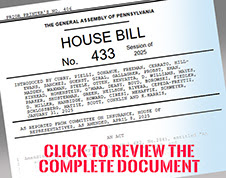By Lennard M. Goetze, Ed.D – AngioMedical News
In a significant step toward improving breast health care equity in Pennsylvania, House Bill 433 (HB433) passed the Pennsylvania House of Representatives with a resounding 198-5 vote on May 12, 2025. This pivotal legislation, aimed at expanding insurance coverage for diagnostic breast examinations without cost-sharing barriers, represents a victory for patients, advocates, and healthcare providers alike.
Background: The Need for HB433 The origins of HB433 trace back more than a year, when Cheri Ambrose, Founder and President of the Male Breast Cancer Global Alliance, reached out to the Pennsylvania Governor’s office and legislative stakeholders to advocate for improved access to breast imaging services — not just for women, but for all individuals, including men diagnosed with or at risk for breast cancer.
Historically, state insurance mandates have focused on screening mammograms, often leaving significant gaps in coverage for diagnostic follow-ups like MRIs, ultrasounds, and diagnostic mammograms when abnormalities are detected. This has led to financial strain and delayed diagnoses for many patients, particularly men with breast cancer, a group frequently overlooked in traditional breast health policy.
Recognizing this, the House Democratic Insurance Committee began work on HB433, designed to ensure that both screening and diagnostic breast imaging would be accessible without burdensome out-of-pocket costs — a move aligned with updated guidelines from the U.S. Health Resources & Services Administration (HRSA) and federal health insurance mandates set to take effect in 2026.
The Legislative Process: Stakeholder Collaboration and Amendment On March 26, 2025, Joseph Keller, Senior Research Analyst for the House Democratic Insurance Committee, formally reached out to stakeholders for feedback on both the bill and a proposed amendment (A00204). This amendment refined HB433’s language to enhance its inclusivity and legal precision. Key changes included:
• Replacing gendered language: Substituting “women” with “individuals” to ensure breast health coverage for all, regardless of gender.
• Clarifying insurance applicability: Modernizing outdated legal references and definitions within Pennsylvania’s mammogram law.
• Defining covered costs: Clearly stating that “all costs” would include copayments, coinsurance, and deductibles — with exceptions for certain high-deductible health plans tied to Health Savings Accounts.
• Aligning with HRSA guidelines: Ensuring diagnostic breast examinations would include MRIs, ultrasounds, or diagnostic mammograms for any suspected abnormalities detected in initial screenings.
Cheri Ambrose remained an engaged advocate throughout the process, communicating regularly with Keller and other House staff to monitor progress. After a successful committee adoption of the amendment in April 2025, the bill was scheduled for a final House vote in May.
Final Passage and What Comes Next
On May 12, 2025, the Pennsylvania House of Representatives Led by House Speaker Rep. Joanna McClinton amended the historical act of May 17, 1921 (P.L.0682, No.0284), known as the "Insurance Company Law Of 1921. The house voted overwhelmingly in favor of HB433. Cheri Ambrose received confirmation of the vote directly from Joseph Keller, who expressed appreciation for the ongoing advocacy and stakeholder input that helped shape the bill’s passage. The bill now moves to the Pennsylvania Senate for further consideration. If approved there, it will proceed to the Governor’s desk for final enactment.
“No one should have to go into debt to access the health care they need, but high out-of-pocket costs can discourage people from seeking care", states Rep. McClinton. By passing HB 433 this week, the state House took action to help more Pennsylvania men and women access diagnostic breast imaging which can save lives and reduce the overall costs to our state’s healthcare system.”
(L-Image) Representative Gina H. Curry - PA General Assembly also shared her statement about the recent historical legislative amendment. “Breast cancer does not discriminate, and neither should access to care. Men get breast cancer too, fathers, brothers, sons, yet many delay care due to stigma or cost. HB 433 ensures that if you find a lump, you can get answers no matter your gender, zip code, or bank account. Black and Hispanic women are more likely to be diagnosed at later stages and have higher mortality rates. Black women are 2.7 times more likely to face triple negative breast cancer and 28 percent more likely to die from it. This bill tears down the financial walls that keep people from getting the diagnostic tests they need. We are not just saving women’s lives, we are saving lives, period. Because cancer does not wait, and neither should we."
What This Means for the Public
For the public — particularly those affected by or at risk for breast cancer — HB433 represents a monumental step forward. Should it become law, Pennsylvanians will no longer face the burden of out-of-pocket costs for essential diagnostic breast exams if abnormalities are detected during initial screenings. This legislation ensures insurance plans offered, issued, or renewed in the Commonwealth will cover these vital services, aligning state law with evolving federal preventive care standards.
Importantly, by adopting gender-neutral language and including men within the framework of breast health care policy, HB433 acknowledges the realities faced by male breast cancer patients, a demographic long overshadowed in public health conversations.
Conclusion
HB433’s progress exemplifies the power of advocacy, stakeholder collaboration, and responsive legislation. As Pennsylvania moves one step closer to codifying these protections into law, advocates like Cheri Ambrose and legislative champions within the House Insurance Committee offer a clear reminder of what dedicated, patient-centered policy work can accomplish.
For more information on male breast cancer and ongoing advocacy initiatives, visit the Male Breast Cancer Global Alliance.




